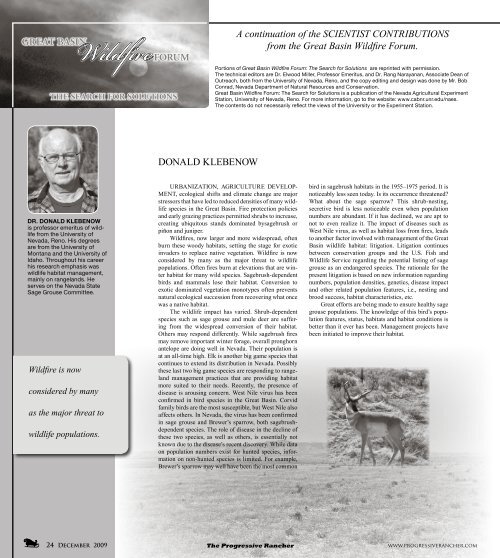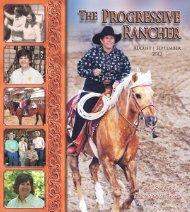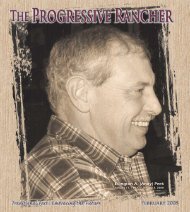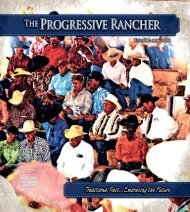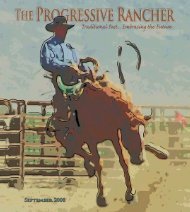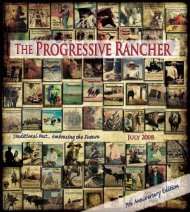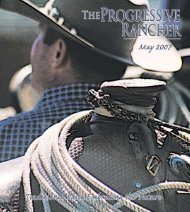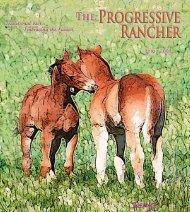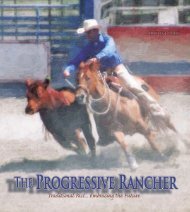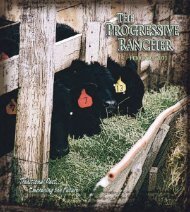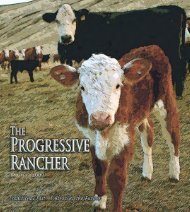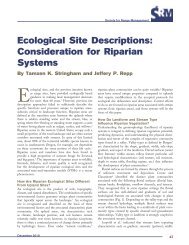The Progressive Rancher Magazine
The Progressive Rancher Magazine
The Progressive Rancher Magazine
You also want an ePaper? Increase the reach of your titles
YUMPU automatically turns print PDFs into web optimized ePapers that Google loves.
A continuation of the SCIENTIST CONTRIBUTIONS<br />
from the Great Basin Wildfire Forum.<br />
GREAT BASINWildfire FORUM<br />
THE SEARCH FOR SOLUTIONS<br />
Portions of Great Basin Wildfire Forum: <strong>The</strong> Search for Solutions are reprinted with permission.<br />
<strong>The</strong> technical editors are Dr. Elwood Miller, Professor Emeritus, and Dr. Rang Narayanan, Associate Dean of<br />
Outreach, both from the University of Nevada, Reno, and the copy editing and design was done by Mr. Bob<br />
Conrad, Nevada Department of Natural Resources and Conservation.<br />
Great Basin Wildfire Forum: <strong>The</strong> Search for Solutions is a publication of the Nevada Agricultural Experiment<br />
Station, University of Nevada, Reno. For more information, go to the website: www.cabnr.unr.edu/naes.<br />
<strong>The</strong> contents do not necessarily reflect the views of the University or the Experiment Station.<br />
DONALD KLEBENOW<br />
dr. DONALD KLEBENOW<br />
is professor emeritus of wildlife<br />
from the University of<br />
Nevada, Reno. His degrees<br />
are from the University of<br />
Montana and the University of<br />
Idaho. Throughout his career<br />
his research emphasis was<br />
wildlife habitat management,<br />
mainly on rangelands. He<br />
serves on the Nevada State<br />
Sage Grouse Committee.<br />
Wildfire is now<br />
considered by many<br />
as the major threat to<br />
wildlife populations.<br />
Urbanization, agriculture development,<br />
ecological shifts and climate change are major<br />
stressors that have led to reduced densities of many wildlife<br />
species in the Great Basin. Fire protection policies<br />
and early grazing practices permitted shrubs to increase,<br />
creating ubiquitous stands dominated bysagebrush or<br />
piñon and juniper.<br />
Wildfires, now larger and more widespread, often<br />
burn these woody habitats, setting the stage for exotic<br />
invaders to replace native vegetation. Wildfire is now<br />
considered by many as the major threat to wildlife<br />
populations. Often fires burn at elevations that are winter<br />
habitat for many wild species. Sagebrush-dependent<br />
birds and mammals lose their habitat. Conversion to<br />
exotic dominated vegetation monotypes often prevents<br />
natural ecological succession from recovering what once<br />
was a native habitat.<br />
<strong>The</strong> wildlife impact has varied. Shrub-dependent<br />
species such as sage grouse and mule deer are suffering<br />
from the widespread conversion of their habitat.<br />
Others may respond differently. While sagebrush fires<br />
may remove important winter forage, overall pronghorn<br />
antelope are doing well in Nevada. <strong>The</strong>ir population is<br />
at an all-time high. Elk is another big game species that<br />
continues to extend its distribution in Nevada. Possibly<br />
these last two big game species are responding to rangeland<br />
management practices that are providing habitat<br />
more suited to their needs. Recently, the presence of<br />
disease is arousing concern. West Nile virus has been<br />
confirmed in bird species in the Great Basin. Corvid<br />
family birds are the most susceptible, but West Nile also<br />
affects others. In Nevada, the virus has been confirmed<br />
in sage grouse and Brewer’s sparrow, both sagebrushdependent<br />
species. <strong>The</strong> role of disease in the decline of<br />
these two species, as well as others, is essentially not<br />
known due to the disease’s recent discovery. While data<br />
on population numbers exist for hunted species, information<br />
on non-hunted species is limited. For example,<br />
Brewer’s sparrow may well have been the most common<br />
bird in sagebrush habitats in the 1955–1975 period. It is<br />
noticeably less seen today. Is its occurrence threatened?<br />
What about the sage sparrow? This shrub-nesting,<br />
secretive bird is less noticeable even when population<br />
numbers are abundant. If it has declined, we are apt to<br />
not to even realize it. <strong>The</strong> impact of diseases such as<br />
West Nile virus, as well as habitat loss from fires, leads<br />
to another factor involved with management of the Great<br />
Basin wildlife habitat: litigation. Litigation continues<br />
between conservation groups and the U.S. Fish and<br />
Wildlife Service regarding the potential listing of sage<br />
grouse as an endangered species. <strong>The</strong> rationale for the<br />
present litigation is based on new information regarding<br />
numbers, population densities, genetics, disease impact<br />
and other related population features, i.e., nesting and<br />
brood success, habitat characteristics, etc.<br />
Great efforts are being made to ensure healthy sage<br />
grouse populations. <strong>The</strong> knowledge of this bird’s population<br />
features, status, habitats and habitat conditions is<br />
better than it ever has been. Management projects have<br />
been initiated to improve their habitat.<br />
24 December 2009 <strong>The</strong> <strong>Progressive</strong> <strong>Rancher</strong><br />
www.progressiverancher.com


